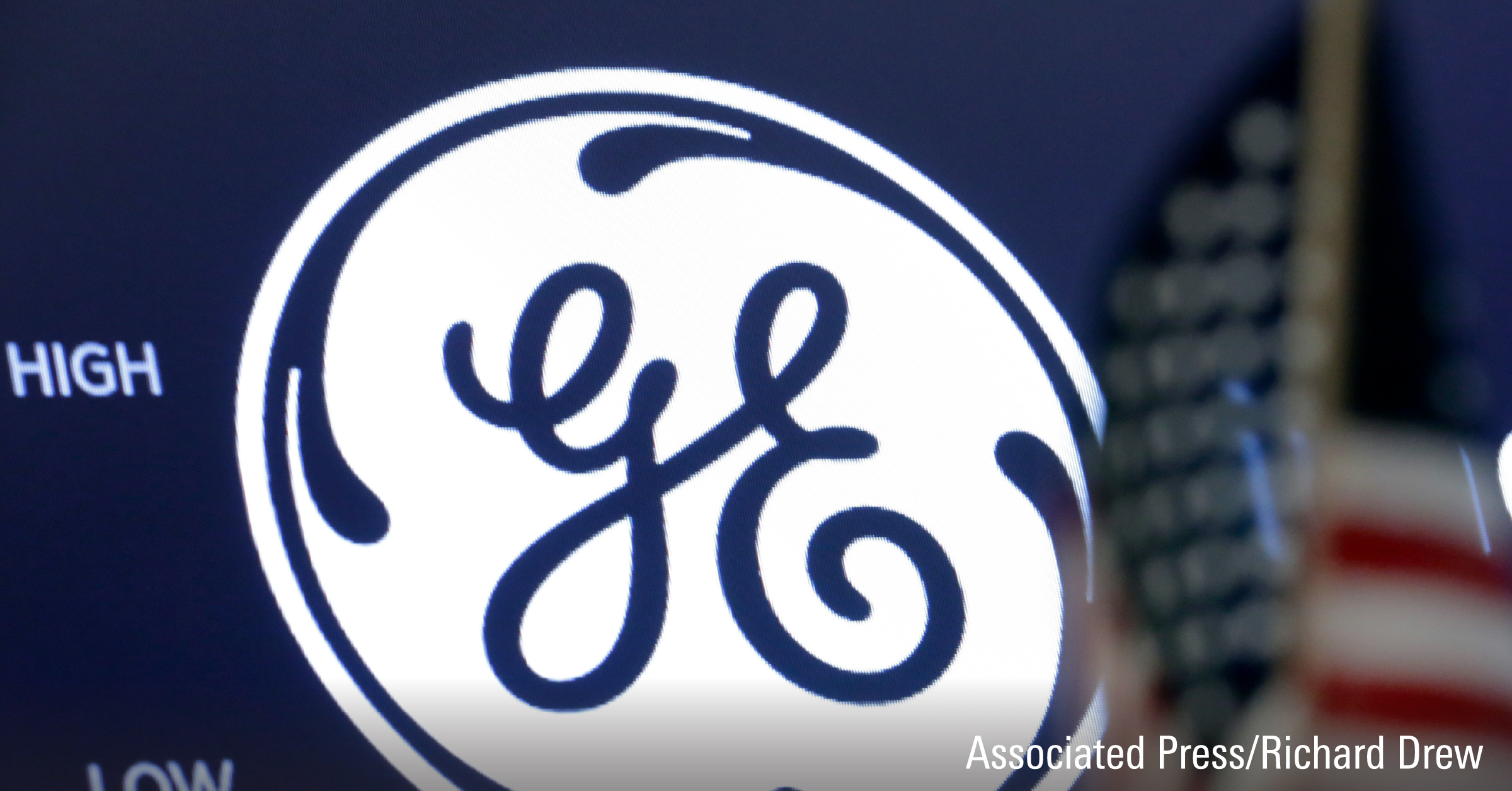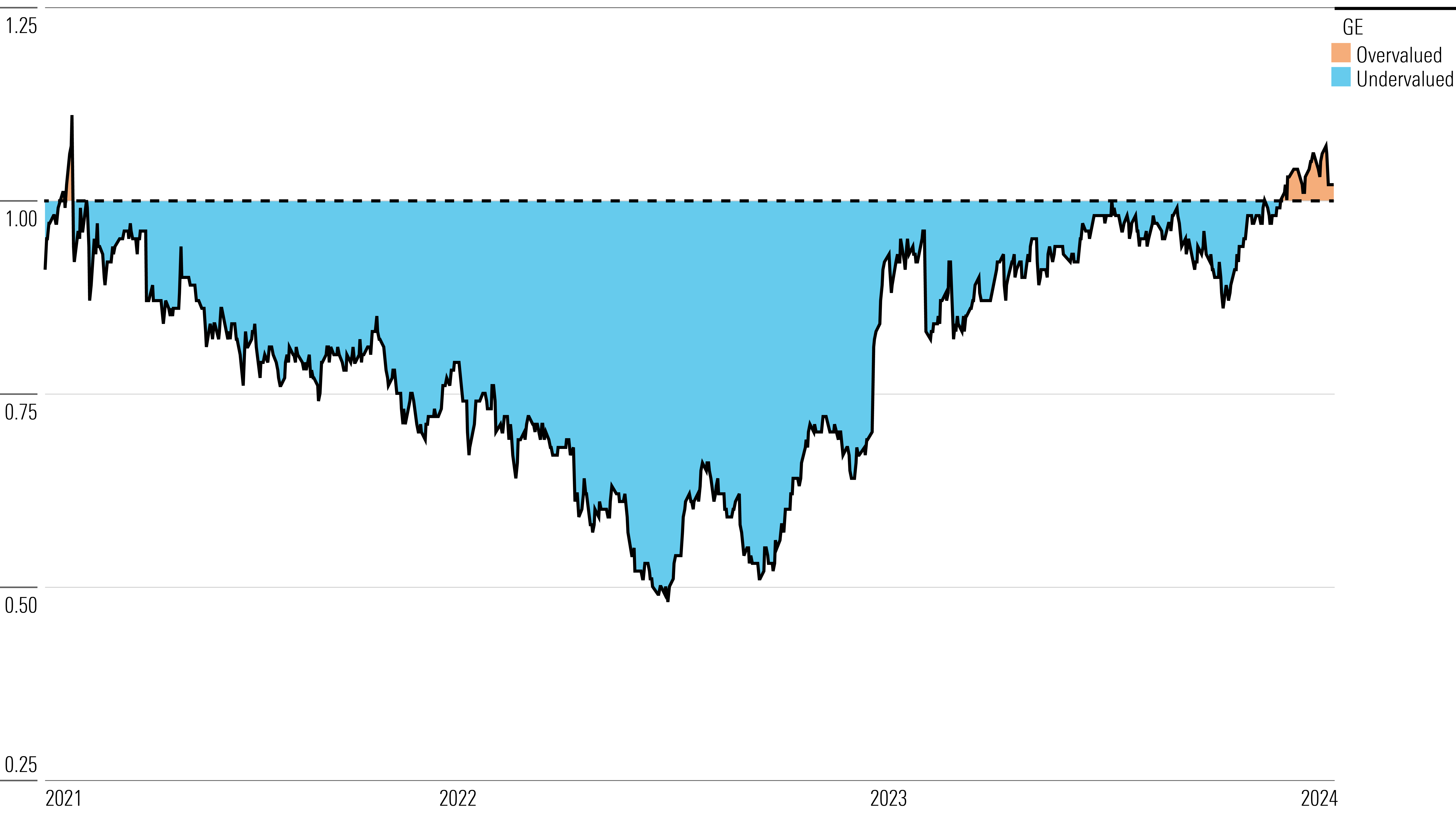After Earnings, Is GE Stock a Buy, Sell, or Fairly Valued?
With commercial aerospace continuing to drive performance, here’s what we think of GE stock.

General Electric GE reported fourth-quarter earnings on Jan. 23. With its stock up 22% over the last three months, here’s Morningstar’s take on the company’s earnings and outlook.
Key Morningstar Metrics for GE Stock
- Fair Value Estimate: $128.00
- Morningstar Rating: 3 stars
- Morningstar Economic Moat Rating: Narrow
- Fair Value Uncertainty: High
What We Thought of GE’s Earnings
Unsurprisingly, commercial aerospace continues to drive performance at General Electric. Total aerospace drove about three-fourths of profitability during the quarter, thanks mostly to a 23% year-on-year increase in services. Encouragingly, demand remains strong here, with the segment boasting a book/bill (orders divided by revenue) of over 1.2 times. Despite a slowing macroeconomic environment affecting shorter-cycled industrials, the slowdown hasn’t reached here.
We think GE’s runway will continue for some time. Departures keep rising as we head into 2024, and GE is still playing catchup with its shop visits, which should grow in the low double digits to mid-teens. Scope and pricing should drive the rest of our near-term forecast, though growth in spares should begin to moderate. In the longer term, we expect this business to remain strong, particularly since it’s more of a cycles-driven than departures-driven business, as narrow-body aircraft get more wear and tear over time.
By management’s admission, leap deliveries will likely come below the just over 2,000 we were expecting. However, this should help aerospace margins, as equipment is a headwind there. Nonetheless, we don’t expect that GE will crack 20% operating margins in aerospace this year, given the considerable ramp. Wide-body 9x engines also ramp in 2025, so we think incremental margins in the low 20s will remain the norm over the medium term.
General Electric Stock Price
Fair Value Estimate for GE Stock
With its 3-star rating, we believe GE’s stock is fairly valued compared with our long-term fair value estimate.
GE’s fourth-quarter and full-year results marginally beat our expectations on most metrics, except free cash flow—mostly due to carrying greater inventory than we expected. Consequently, we lift our fair value estimate by 4% to $128, though over half of the raise is due to the time value of money. However, we expect to reevaluate further as GE issues additional filings, including its 10-K and its investor day in early March.
We think the market is looking to 2025 when valuing GE, and we value the firm at nearly 21 times our 2025 adjusted EPS expectations. We think GE Aerospace will trade for roughly $110 billion in equity value, while GE Vernova will trade for over $30 billion in equity value, based on our assessment of each business.
Commercial aerospace remains the most important driver of our valuation; its fundamentals are still strong. Most of GE’s fleet of narrow-bodies have yet to see their first shop visit, and travel remains a continued priority in people’s budgets. Continued evidence of pent-up demand in strong backlog and order strength (1.2 book/bill ratio) gives us continued confidence that GE Aerospace revenue will grow at a low-to-mid-teens percentage in 2024 relative to 2023. Departures keep rising heading into 2024, which bodes well for deliveries, and GE still must play catch-up with its shop visits. In the longer term, we expect the firm’s commercial service business will remain strong, particularly since it’s more cycle-driven than departure-driven (narrow-bodies receive more wear and tear over time).
GE Historical Price/Fair Value Ratio

Read more about GE’s fair value estimate.
Economic Moat Rating
We assign General Electric a narrow moat based on switching costs and intangible assets stemming from its massive installed base of industrial equipment and differentiated technology. We hold off on assigning the company a wide moat rating because of our lack of confidence in its 20-year hurdle rate for excess return on capital.
GE Aerospace meets our highest standard of a wide-moat business and is GE’s crown jewel. The segment benefits from intangible assets and switching costs, and we think it is the premier commercial engine manufacturer that can deliver at scale. GE competes in a virtual duopoly in both the wide-body (twin-aisle) and narrow-body (single-aisle) space against Rolls-Royce and Pratt & Whitney. Excluding its 50% interest in the CFM joint venture with Safran, we estimate that GE typically commands roughly half of the total commercial engine market as measured by the installed base.
The aviation segment operates on a razor-and-blade model. A GE/CFM engine is present in three of every four commercial departures. In the formative years after a new engine launch (about one-third of the overall cost of a new plane), GE will typically implement an estimated 70% discount on its new narrow-body engines from their listed prices. Over time these discounts erode. A typical jet engine will first require service in about its seventh year of operation, at which time an engine program may pass breakeven and become a recurring (and enviable) profit stream. These bespoke service contracts typically extend for 25 years.
We believe intangible assets are particularly critical for engine deliveries—the razor in the razor-and-blade model. The technical knowledge needed to design and manufacture a jet engine is GE’s main source of intangible assets. This know-how is supported by the firm’s research and development budget, of which about one-third is principally funded by the U.S. government. Other intangible assets include the firm’s patents, long record of success, and customer relationships with both Boeing BA (primarily) and Airbus. A record of success can have a disproportionate impact on delivery wins.
Read more about GE’s moat rating.
Risk and Uncertainty
GE’s principal risk is related to the fallout of COVID-19 on its commercial aerospace business, including government interventions and acceleration of infections that ultimately affect both revenue passenger kilometers (demand) and load factors (utilization). Additional risks include significant cash burn amid pricing pressures in some operating businesses, including renewable energy, and the firm’s insurance liabilities (though they’ve been less of a concern in recent years, given rising interest rates). Finally, GE has a large key-person risk in CEO Larry Culp. Losing him before a successful turnaround would pose critical headline and fundamental risk, in our view.
We think GE faces few environmental, social, or governance risks that aren’t well-known to investors by now. These include government investigations into its accounting practices, shareholder lawsuits, potential embargoes from defense sales, and the impact of the global energy transition on the gas and steam turbine business (though GE exited its new coal build business, and the energy transition mostly helps with sales of renewables). We think the greatest ESG risk relates to fallout from the climate impact of aerospace engines—though we don’t think this is enough to be material, and we point out that GE is developing a next-generation sustainable engine within its CFM Rise program. The firm has also teamed up with NASA to develop hybrid electric engine technology to address climate issues. Given its technology leadership, we expect GE will remain ahead of its competitors, which should ameliorate investor concerns.
Read more about GE’s risk and uncertainty.
GE Bulls Say
- Bears vastly underestimate the incremental profits GE will make from operating leverage when commercial aerospace fully recovers, as well as the windfall from the Inflation Reduction Act.
- In our view, GE is led by the premier U.S. multi-industry CEO. Culp has assembled a team of leaders who are steadily changing GE’s culture to one that embraces lean principles.
- GE’s installed base boasts the youngest fleet, with nearly 50% of its CFM fleet yet to make its first shop visit. This bodes well for its high-margin aftermarket business.
GE Bears Say
- GE’s turnaround has a lot of unknowns, including when renewables will finally reach profitability and when the Inflation Reduction Act will move toward full implementation.
- While GE will generate orders from the energy transition, it has consistently made negative earnings from both Power and Renewables, and new equipment orders will only pressure and dilute margins further.
- Bulls vastly underestimate the amount of contingent liabilities that GE will have to contend with.
This article was compiled by Tom Lauricella.
The author or authors do not own shares in any securities mentioned in this article. Find out about Morningstar’s editorial policies.


/cloudfront-us-east-1.images.arcpublishing.com/morningstar/ECVXZPYGAJEWHOXQMUK6RKDJOM.jpg)
/cloudfront-us-east-1.images.arcpublishing.com/morningstar/KOTZFI3SBBGOVJJVPI7NWAPW4E.jpg)
/cloudfront-us-east-1.images.arcpublishing.com/morningstar/V33GR4AWKNF5XACS3HZ356QWCM.jpg)